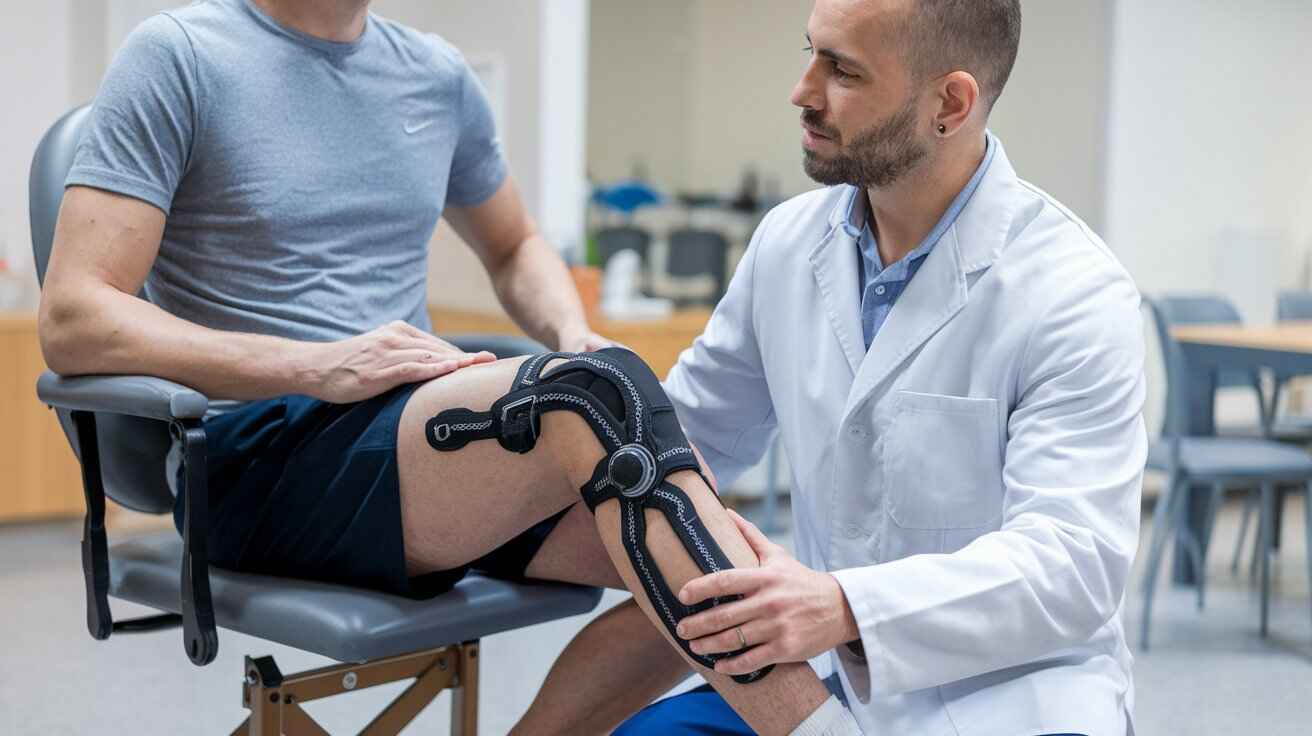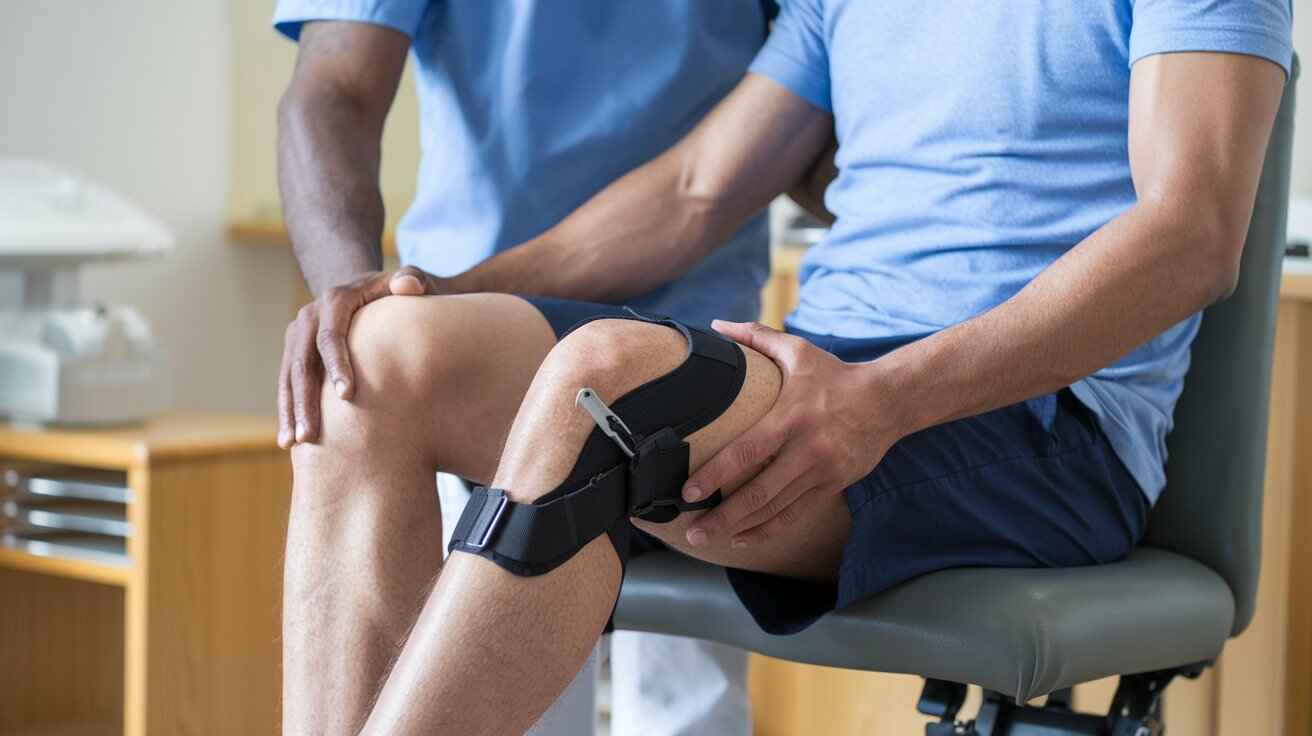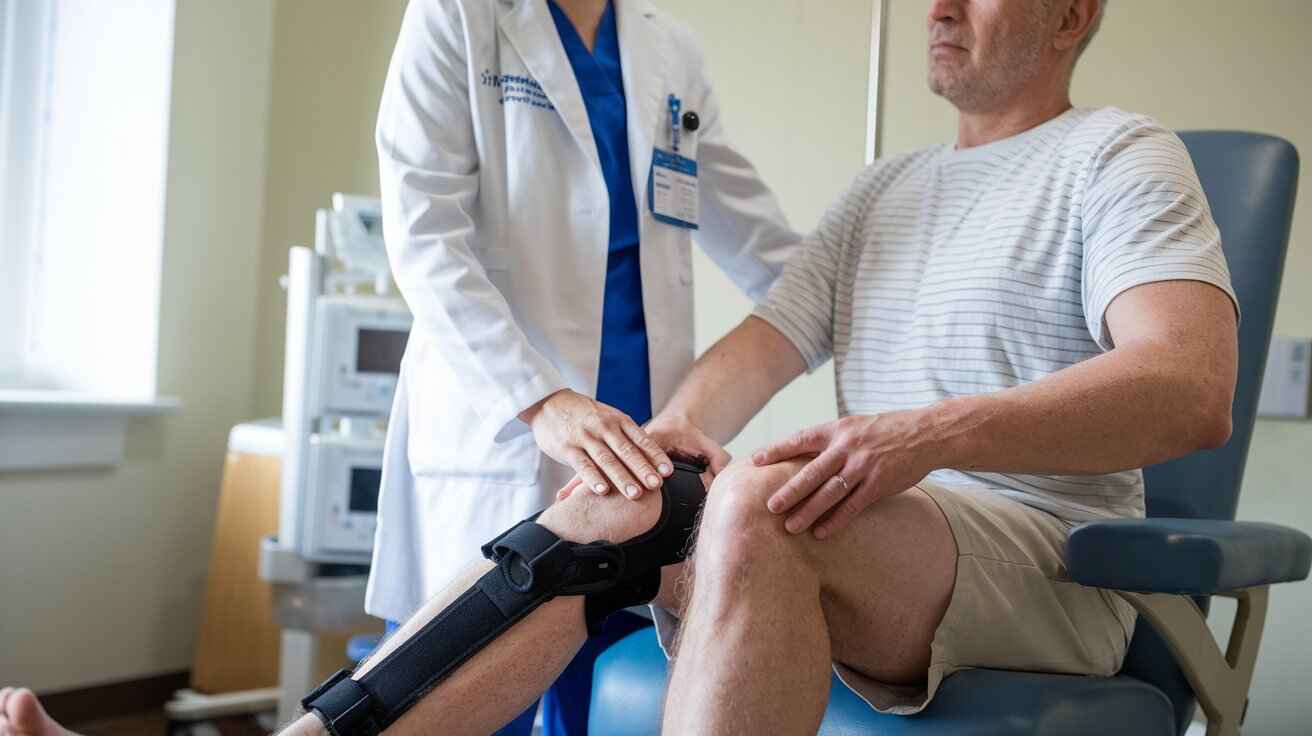The Critical Role of Physiotherapy in Knee Replacement Recovery
Congratulations on your total knee replacement surgery! While the procedure marks a significant milestone in your journey toward pain-free mobility, what happens during your recovery is equally crucial for long-term success. Physiotherapy after total knee replacement isn't just beneficial—it's essential for achieving optimal outcomes and regaining independence.
At Dr. Debashish Chanda's orthopedic practice, we've helped thousands of patients navigate their post-surgical recovery with comprehensive, evidence-based rehabilitation protocols. This guide outlines our detailed total knee replacement physiotherapy protocol, giving you the knowledge and confidence to participate actively in your healing journey.
Whether you've already undergone surgery or are preparing for an upcoming procedure, understanding the rehabilitation process This will help you set realistic expectations andachieve the best possible results. Let's explore how targeted physiotherapy can transform your surgical outcome from good to excellent.
Why Physiotherapy Is Crucial After Knee Replacement

Following total knee replacement surgery, your body must adapt to the new artificial joint while rebuilding strength, flexibility, and proper movement patterns. Without appropriate rehabilitation, patients commonly experience:
- Persistent stiffness and limited range of motion
- Prolonged pain and swelling
- Difficulty with everyday activities like stairs and walking
- Muscle weakness that affects stability and function
- Altered gait patterns that may impact other joints
A structured total knee replacement physiotherapy protocol addresses these challenges proactively, helping you avoid complications and achieve better functional outcomes. Research consistently shows that patients who adhere to their rehabilitation program recover faster and report higher satisfaction with their surgical results.
The Science Behind Post-Surgical Rehabilitation
The physiological process of recovery after knee replacement involves several key elements:
- Managing inflammation: Controlling initial swelling to create an optimal healing environment
- Preventing adhesions: Early movement prevents excessive scar tissue formation that could restrict mobility
- Neuromuscular re-education: Teaching muscles to work correctly with the new joint mechanics
- Progressive loading: Gradually increasing stress on tissues to build strength without causing damage
- Functional retraining: Relearning movement patterns for daily activities
Dr. Chanda's comprehensive protocol incorporates all these elements in a progressive, individualized approach that evolves as you heal.
The Complete Total Knee Replacement Physiotherapy Protocol: Week by Week
Pre-Surgery Preparation (Prehabilitation)

While often overlooked, preparation before surgery significantly impacts your recovery trajectory. Patients who participate in "prehabilitation" typically experience:
- Faster post-operative progress
- Lower pain levels
- Earlier return to independence
- Better understanding of exercises they'll perform after surgery
Recommended pre-surgery exercises include:
- Straight leg raises
- Gentle knee flexion and extension
- Quadriceps sets (isometric contractions)
- Core strengthening
- Upper body conditioning to prepare for crutch or walker use
Your physiotherapist will evaluate your current condition and... Develop a personalized rehabilitation program designed specifically for your unique needs and abilities.
Phase 1: Immediate Post-Surgical Period (Days 1-14)
The initial phase begins immediately after surgery, often while you're still in the hospital. Goals during this critical period include:
Days 1-3: Hospital-Based Therapy
- Control pain and swelling using ice, elevation, and medication
- Achieve basic mobility for safe discharge (transfers, short walks with assistance)
- Begin gentle range of motion exercises
- Learn proper use of assistive devices (walker or crutches)
- Understand home exercise program and precautions
Key exercises in this phase:
- Ankle pumps to prevent blood clots
- Quadriceps sets (gently tightening the thigh muscle)
- Gluteal sets (gently squeezing buttock muscles)
- Heel slides for gentle knee flexion
- Assisted knee extension stretches
Days 4-14: Early Home Recovery
- Continue with progressive knee flexion and extension exercises
- Begin weight-bearing as tolerated (following surgeon's guidelines)
- Focus on proper gait pattern with an assistive device
- Manage swelling through elevation, ice, and compression
- Gradually increase walking distance
Expected milestones by the end of Phase 1:
- Knee flexion of approximately 90 degrees (ability to bend the knee to a right angle)
- Near-complete knee extension (ability to straighten leg)
- Independence with basic transfers and short-distance walking
- Understanding of home exercise program
Phase 2: Building Foundation (Weeks 2-6)
During this phase, you'll likely begin outpatient physiotherapy sessions while continuing your home exercise program. The focus shifts toward:
- Improving range of motion to functional levels
- Building basic strength in the quadriceps, hamstrings, and hip muscles
- Enhancing balance and proprioception (positional awareness)
- Progressing toward more independent mobility
Key exercises in this phase:
- Progressive knee flexion stretches
- Standing terminal knee extension exercises
- Seated knee extension with light resistance
- Supported mini squats
- Step-ups (small height)
- Stationary cycling with minimal resistance
- Balance exercises with support
Expected milestones by the end of Phase 2:
- Knee flexion of 105-110 degrees
- Full or near-full knee extension
- Ability to walk longer distances with decreased dependence on assistive devices
- Improved confidence with daily activities
Phase 3: Functional Strengthening (Weeks 6-12)
As healing progresses and a basic range of motion is established, emphasis shifts toward more functional strength training and activity-specific rehabilitation:
- Progressive resistance training for all lower extremity muscle groups
- More challenging balance and proprioceptive exercises
- Gait training without assistive devices (as appropriate)
- Focus on stair navigation, transfers, and daily living tasks
- Introduction of low-impact cardiovascular conditioning
Key exercises in this phase:
- Forward and lateral step-ups with increasing height
- Leg press with appropriate resistance
- Hamstring curls with light resistance
- Standing calf raises
- Stationary cycling with moderate resistance
- Walking program with increasing distance and speed
- Balance exercises on unstable surfaces
Expected milestones by the end of Phase 3:
- Knee flexion of 110-120 degrees
- Independence with daily activities
- Minimal pain with activity
- Ability to walk continuously for 15-20 minutes
- Safe navigation of stairs with alternating feet
Phase 4: Advanced Conditioning and Return to Activities (3-6 Months)

The final phase focuses on optimizing function and safely returning to desired recreational activities:
- Sport-specific or activity-specific training
- Advanced balance and agility exercises
- Ongoing strength progression
- Endurance building
- Fine-tuning of movement patterns
Key exercises in this phase:
- Advanced closed-chain strengthening (lunges, deeper squats as appropriate)
- Multi-directional stepping and movement patterns
- Tailored exercises for specific recreational goals
- Interval training for endurance
- Dual-task activities (combining cognitive and physical challenges)
Expected milestones by the end of Phase 4:
- Knee flexion appropriate for desired activities (typically 120-130 degrees)
- Return to most low-impact recreational activities
- Normal or near-normal gait pattern
- Good muscular endurance for sustained activity
- Confidence in knee function for daily life
Special Considerations in Your Total Knee Replacement Physiotherapy Protocol
Managing Pain During Rehabilitation
Some discomfort during physiotherapy is normal and expected. However, excessive pain can hinder progress. We recommend:
- Timing pain medication appropriately before therapy sessions
- Using ice before and after exercise
- Distinguishing between therapeutic discomfort and problematic pain
- Communicating openly with your physiotherapist about pain levels
- Modifying exercises when needed without eliminating them
The "no pain, no gain" philosophy does not apply after knee replacement—pain should be managed to enable productive rehabilitation, not endured unnecessarily.
Addressing Common Challenges
Persistent Stiffness
If the range of motion plateaus despite consistent exercise:
- More frequent gentle stretching throughout the day
- Use of heat before stretching to increase tissue extensibility
- Possible adjustments to therapy techniques
- In some cases, consideration of manipulation under anesthesia (rare)
Quadriceps Weakness
This common issue can persist for months after surgery:
- Focus on neuromuscular re-education.
- Use of biofeedback or electrical stimulation when appropriate
- Emphasizing both open and closed-chain strengthening
- Addressing compensations that may develop
Swelling Management
Prolonged swelling can delay recovery and increase discomfort:
- Elevation of the leg above heart level multiple times daily
- Compression garments or wraps, as recommended
- Contrast therapy (alternating cold and warm)
- Gentle ankle pumps and circulation exercises
- Avoiding prolonged sitting or standing
Benefits of Following a Structured Physiotherapy Program
Patients who commit to their total knee replacement physiotherapy protocol typically experience the following:
- Faster return to independence: Research shows that consistent rehabilitation reduces dependence on caregivers and assistive devices.
- Better range of motion: Studies indicate patients gain an additional 10-15 degrees of flexion with supervised therapy compared to minimal intervention.
- Reduced risk of complications: Regular movement decreases risks of blood clots, excessive scar tissue, and prolonged stiffness.
- Improved confidence: Learning how to safely navigate various environments with your new knee reduces anxiety about falling or re-injury.
- Higher overall satisfaction: Patients reporting good adherence to rehabilitation typically express greater satisfaction with their surgical outcomes.
- Longevity of the implant: Building proper strength and movement patterns may contribute to longer implant life by optimizing biomechanics.
Cost Factors for Post-Surgical Physiotherapy
Understanding the financial aspects of rehabilitation can help you plan appropriately:
Insurance Coverage
Most insurance plans, including Medicare, cover post-surgical physiotherapy, though limitations may apply:
- Number of covered visits (typically 10-20 sessions)
- Requirements for physician referrals or pre-authorization
- Network restrictions for providers
- Co-payments or coinsurance requirements
Home Equipment Considerations
Basic equipment for home exercises is generally inexpensive:
- Resistance bands ($10-20)
- Foam roller ($20-30)
- Cold packs ($15-25)
- Simple exercise props like pillows or towels
More advanced equipment like stationary bikes or recumbent steppers represents an optional investment ranging from $200-1000+.
Long-term Value
While there are costs associated with rehabilitation, consider them an investment in your long-term outcome. The expense of comprehensive physiotherapy is minimal compared to the cost of complications or revisions that might result from inadequate rehabilitation.
Dr. Chanda's office staff can help you understand your specific coverage and explore options if financial constraints affect your ability to participate in recommended therapy.
Frequently Asked Questions About Knee Replacement Rehabilitation
How long will I need physiotherapy after my knee replacement?
Most patients benefit from supervised physiotherapy for 2-3 months, followed by a home program for several more months. However, this varies based on individual factors, including pre-operative condition, age, other health concerns, and commitment to home exercises.
Is physiotherapy painful after knee replacement?
Some discomfort during and after exercise is normal, especially in the early phases. However, therapy should not cause severe pain. Your physiotherapist will help distinguish between productive discomfort and problematic pain, modifying your program accordingly.
When can I drive after knee replacement?
Most patients can resume driving when they have adequate control of the operative leg and have discontinued narcotic pain medications—typically 3-6 weeks after surgery. This timing varies based on which knee was replaced (right vs. left) and the type of vehicle you drive.
How often should I do my home exercises?
Most home exercise programs include daily activities, often performed 2-3 times per day in shorter sessions rather than one long session. Your physiotherapist will provide specific frequency recommendations based on your phase of recovery and individual needs.
Can I damage my new knee by exercising?
When following your prescribed total knee replacement physiotherapy protocol, the risk of damaging your implant is extremely low. Modern knee replacements are designed to withstand appropriate exercise stress. Your physiotherapist will ensure activities are appropriate for your stage of healing.
Making the Most of Your Rehabilitation Journey
To optimize your recovery, consider these practical strategies:
- Set specific, measurable goals with your physiotherapist—having targets to work toward increases motivation.
- Create a consistent routine for exercises, incorporating them into your daily schedule.
- Keep a record of your progress in a journal or using an app., noting improvements in range of motion, strength, and function.
- Communicate openly with your healthcare team about challenges, pain, or concerns.
- Find an exercise buddy or support person who can encourage your efforts.
- Celebrate small victories along the way—acknowledge each improvement as an achievement.
- Be patient with the process—recovery typically continues for up to a year after surgery.
Conclusion: Your Commitment Makes the Difference
The total knee replacement physiotherapy protocol outlined in this guide provides a roadmap for recovery, but your active participation is what truly determines the outcome. At Dr. Debashish Chanda's practice, we partner with you throughout this journey, providing expert guidance, encouragement, and adjustments to your program as needed.
Remember that recovery isn't always linear—you may experience plateaus or temporary setbacks along the way. With persistence and proper guidance, most patients achieve excellent long-term results that significantly improve their quality of life.
We encourage you to approach your rehabilitation with both determination and patience. Your commitment to the process today builds the foundation for years of improved mobility tomorrow.
Have questions about your rehabilitation program or need to schedule a physiotherapy consultation? Contact Dr. Chanda's office at [PHONE NUMBER] or request an appointment through our online scheduling system.
This article is meant for educational purposes only and should not be regarded as professional advice.professional medical advice. Always adhere to the specific guidelines that are provided to you. surgical team and physiotherapist, as individual needs may vary.






